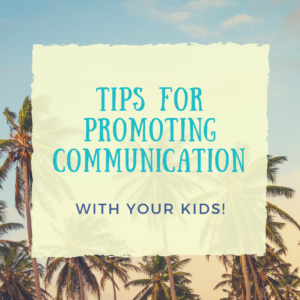“I’m fine!” Tips for breaking down communication barriers between you and your child

How many times have you tried to have a deep and meaningful conversation with your child? How many times have you asked “what’s wrong”? How many times have you thought in all caps in your head “JUST TELL ME PLEASE!” Some kids and adolescents will open right up and let you know everything that is going on in their lives. AWESOME! But there are so many others that will say the infamous “I’m fine” as they are yelling and slamming their bedroom door. “Sure you’re fine” you think. As a therapist at InMindOut, who uses play therapy techniques often in sessions, I have come to see how using some simple, but often forgetful, techniques can be helpful for opening up dialogue with children and teens who just don’t like to talk. So, today I’m laying out some tips to help break down conversational barriers with your kids and teens that you may have not tried before or just need a reminder about.
-
What does my child like?
Know the likes and dislikes of your child. Tailor your approaches to what they are actually interested in. Music? What music do they like? Books? Which ones? Sports? Movies? Anime? TV shows? Traveling? Gaming? Taking a genuine interest in their interests already begins to break down barriers of communication. Do you hate the rap music they listen to? Probably. But, they connect with it for a reason. Therefore, asking questions about what they like, asking to listen to their favorite song, or asking them to tell you what their current TV show obsession is about can be helpful in enhancing your relationship with them. But beware, asking “why do you listen to that” as soon as they answer and being judgmental about their interest can set you back. Say things such as, “I can see why you like it, it has a good beat” even though the lyrics make you cringe inside. They may not open up about their feelings or that bully at school right away but you have just let them know that you are open to them being their own person and having likes, dislikes, and feelings that are different from yours. And that is A-OK!
-
Games!
Card games, board games, dominos, trivia, etc. I frequently use games in session to take the edge off sitting on a couch and speaking directly to your therapist about uncomfortable situations. Having something in your hands like cards or a puzzle piece helps with self-regulation and can reduce anxiety, making talking about a difficult or uncomfortable situation easier. Have fun first though! Therapists often need to take time to build rapport with children and teens. It’s a good idea that parents do the same with their children. Maybe you already have good rapport, great! But if you feel your relationship has been distant lately (calling all parents with teens!) take time to have fun with the games first. No uncomfortable questions, no sneaking in a lecture. Enjoy! Make it competitive if that helps. What could they win? Getting off dish duty? 1 piece of candy? Then, when you feel the connection and rapport with your child start to grow, try starting up casual conversation. Be aware of their responses. Too soon or just right? You can modify games as well to spark conversation. Tip: Vary your topics. If you are going to add questions to your game, make some more challenging than others. For example, here is one that I use: UNO! Every time you use a wild, skip, draw 2, or reverse you answer a different question. I use topics such as favorite foods, places to travel to, best movies, etc. Then I’ll throw in questions or fill in the blank sentences such as “I feel angry when____”, name a happy memory, one thing I do well, and/or I thing I want to do better.
-
Have little ones?
Enter your child’s world! By this I mean, try getting on the floor with them and playing how they want to play. Sit down in front of them and ask them to play too. You will be amazed at what you can find out from just picking up on themes from your child’s play. Then, use their toys to communicate. Communicating directly to a young child about a situation at school over and over can sometimes go in one ear and out another. However, by using their toys to tell a story or act out a similar situation you can create more of a lesson than you think. Afterwards you can also always refer back to “Remember what Hippo told Bunny to do when that happens”.
Using these strategies at home can also help your child in therapy. Often your child’s therapist wants to know how things are going at home. Being aware of these tips and recalling their reactions or behaviors towards these approaches can help guide the therapist in the right direction in regards to working on your child’s or teen’s emotional health. So why not try them out or try them again? How did it go? What challenges came up? Have you consulted with your child’s therapist? Let us know!
I’ll be back soon with some more tips. Stay tuned!
Loriana Martin, MA, LPC
InMindOut Emotional Wellness Center, LLC
